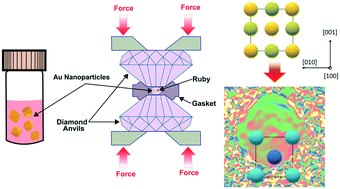Orthorhombic distortion in Au nanoparticles induced by high pressure
Abstract
It is well known that the properties of metal nanoparticles strongly depend on their size. This dependence can generate unusual structures, and it enabled induction of phase transitions at lower pressure and temperature compared to the bulk materials. Bulk transition metals do not have phase transitions under ambient conditions. Bulk gold phase transitions are expected at pressures above 200 GPa. Herein, it is reported that an orthorhombic lattice distortion in single-crystal truncated-octahedral gold nanoparticles is induced by applying a high pressure below 12 GPa in a diamond anvil cell at room temperature (295 K). An asymmetrical lattice distortion of ∼3% along the lattice planes, detected through atomic-resolution electron microscopy and electron diffraction, indicated that lattice strain generated by the imposed experimental conditions led to a transition from a cubic to an orthorhombic structure. Interestingly, the mentioned lattice distortion was not observed in twinned nanoparticles subjected to the same pressure and temperature conditions. The lattice deformation took place at a much lower pressure and temperature compared to that of bulk gold, demonstrating dependency on the particle shape and structure. The experimental results reflect not only a size effect, but also a strong surface, morphological, and structural effect on the behavior of materials at the nanoscale under high-pressure conditions.



 Please wait while we load your content...
Please wait while we load your content...